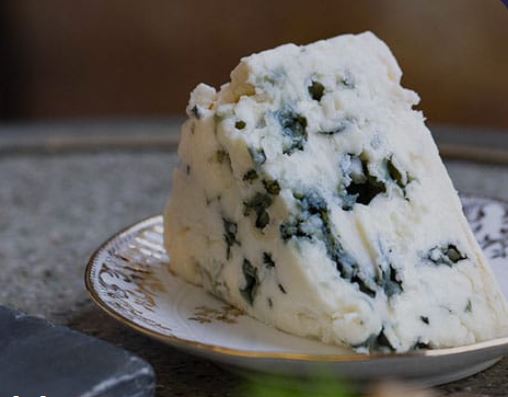Roquefort, a blue-veined sheep’s cheese from Aveyron, , embodies taste and pleads for the diversity of flavors.

From the chalky mountain of Combalou
It is in the heart of Aveyron that Roquefort was born, the first French cheese to have received an appellation of origin, in 1925. The history of this blue-veined cheese is linked to a region : the chalky mountain of Combalou, in Roquefort-sur-Soulzon, south-east of Rodez. “Only Roquefort will be what comes out of the Roquefort cellars”. Formed naturally in the mountains by erosion and landslides, the Roquefort cellars are the one and only places where the cheese matures, in which it must spend a minimum of 14 days. These cellars are called fleurines. Only the refining must be in Roquefort, the collection of milk from Lacaune breed sheep takes place in a much wider area. It extends over the entire department of Aveyron and some municipalities in neighboring departments.
The king of cheeses
In 2020, nearly 16,000 tonnes of Roquefort AOP were marketed (source: AOP dairy products). The legend of Roquefort Qualified as the king of cheeses by Diderot and d’Alembert, Roquefort is the oldest cheese Appellation d’origine, obtained in 1925. Before that date, it was made with goat’s milk and sheep’s milk. Today, it is exclusively made with Lacaune breed ewes. Legend has it that Roquefort was born of pure chance : a shepherd one day forgot his bag in a cave. When he came back some time later, his bread was moldy, his sheep’s cheese had turned blue. In reality, it is rather assumed today that the veins that appeared randomly on this cheese were due to the mixture of goat’s and sheep’s milk.

3 months are needed to produce Roquefort
Cheese making Mold is caused by a fungus called penicillium roqueforti. It is added to milk during production. To promote its development, the cheese is pierced with forty holes over its entire height. The humidity and the perfect control of the temperature of the cellars also play an important role in its appearance. It is this mushroom that gives all its taste and creaminess to the cheese. For 15 days to 3 weeks, the cheese is displayed in the cellars. When the cellar master considers that the development of Penicillium Roqueforti within the cheese is sufficient, the “loaves” are wrapped in tin foil and kept in rooms at low temperatures to continue their slow maturation. A minimum of three months are needed to produce Roquefort.
Exported to 105 countries
From the Netherlands to Morocco, from Brazil to Japan, from Scandinavia to Australia, Roquefort blends in all latitudes, all meridians. It is exported to 105 countries, a true Phileas Fogg of the taste buds, and loses none of its prestige in the kingdom of Manchego or the country of Gorgonzola where it is given « His Excellency ». Roquefort, said Diderot, contributes to the international influence of French gastronomy just like Champagne. Undeniably. A fifth of Roquefort production travels outside of France. Germany, Belgium and the United States are the first tasters abroad. But Roquefort can be savored just as well in Uruguay, Slovakia, Singapore, Senegal, Norway, Mexico or Mauritius.






Laisser un commentaire